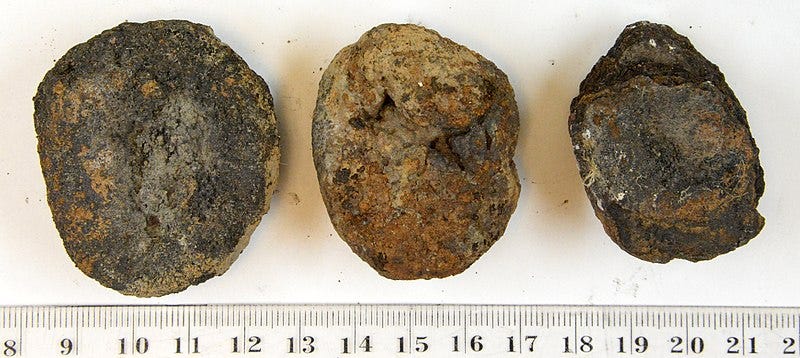Let’s start with a primer on polymetallic nodules. They’re the resource most in demand by deep-sea mining firms. Everyone calls them potatoes—and they do look dull and unassuming. But polymetallic nodules are fascinating geologically. Here’s their life story (the short version):
Millions of years ago, a shark loses a tooth. That tooth sinks to the seabed, landing on a vast abyssal plain beneath miles of seawater. A manganese-bearing molecule precipitates out of the seawater and sticks to the tooth. Then iron. Then cobalt. The tooth becomes completely covered in a metallic crust. That crust grows by a couple millimeters every million years. Until humans discover it and decide it looks like a potato.
(Note: the nucleus for a polymetallic nodule isn’t always something as cool as a shark tooth. It could be a fleck of shell or other organic matter.)
This process has repeated trillions of times, yielding trillions of nodules. Some parts of the abyssal plain look like cobblestone streets, because they’re so packed with nodules.
One such region is the Clarion-Clipperton Zone (CCZ)—a broad swath of the eastern Pacific Ocean between Hawaii and Mexico. The CCZ draws more mining interest than anywhere else, because it bears a truly staggering amount of metal.
Polymetallic nodules within the CCZ alone contain more cobalt, nickel and manganese than all combined land-based reserves of those metals. A single firm, The Metals Company, has plans to mine an area of the CCZ with enough of these metals to electrify the entire passenger vehicle fleet in the U.S.
And that’s just a single resource (polymetallic nodules) in a single place (the CCZ). Other firms are seeking to mine hydrothermal vents in the Indian and Atlantic Oceans, as well as undersea mountains in the western Pacific.
According to scientists with the U.S. Geological Survey, “If deep-ocean mining follows the evolution of offshore production of petroleum, we can expect that about 35–45 per cent of the demand for critical metals will come from deep-ocean mines by 2065.”
TL;DR, there’s a lot of metal at the bottom of the ocean. But that’s not to say it’s all necessary for the energy transition.
Land-based geologic reserves “are sufficient to meet all projected future demand,” according to a study published last year in the journal Joule. We’re not going to suddenly run out of nickel. Instead, high demand could push metal prices up and slow the deployment of renewable energy. In theory.
In fact, commodity metal markets are notoriously volatile, and prices have cratered in recent months. Such instability has long muddied the business case for opening new mines—whether at the bottom of the ocean or not.
(Header image by Hannes Grobe. Manganese nodules from the Baltic Sea. CC BY-SA 4.0)



